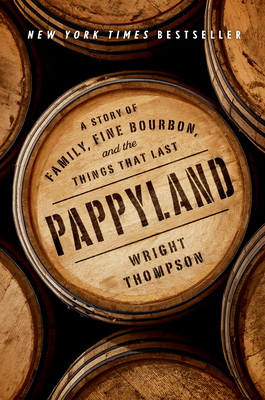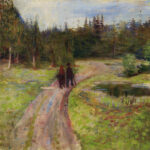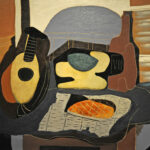As Wright Thompson makes clear in his recent book Pappyland, pouring a tumbler of bourbon amounts to far more than relocating some aged, brown spirit from one glass to another for the purpose of consumption. Cascading down that slick, clear concavity is a coalescing of a whole host of very human things: tradition, piety, place, craft, and commercialized nostalgia, as well as fragility, memory, and loss. Hence the book’s subtitle: A Story of Family, Fine Bourbon, and the Things that Last.
Yet these lasting things—the seemingly permanent things—are often too big or too rich or too close. Too much to look at full on, directly. When we do get a glimpse, they can send an existential shiver down the spine of the soul. Or bewilder us with their grandeur, or maybe even haunt us as specters of promises unkept and debts unpaid.
It’s helpful, then, to peer at them sideways or throughways. That is, in and through those things we find ourselves doing at 4 o’clock on a Saturday afternoon. And so it is that we begin with our author at Churchill Downs, the day before the Kentucky Derby. He’s in search of Julian van Winkle, the present patriarch of the van Winkle clan and caretaker of the almost-lost-but-now-recovered Pappy Van Winkle bourbon legacy.
As we travel with Thompson and van Winkle from this horse track through to the end of the book, we consider those really big things that send tremors of vibrancy and meaning through our lives. We see with Thompson that “horse racing, like bourbon, makes these big ideas small enough to see.”
The narrative that unfolds in Pappyland is one of intertwining: Past and present. Home and exile. Failure and lightly held success. Thompson and van Winkle, as well. In compelling fashion our author can’t help but see his own story wrapped up with the Pappy drama, of which Julian is the inheritor. This self-referential move from the author surely invites the reader to do the same, and we should be glad for the opportunity to consider our lives in light of what transpires on the page.
Pappyland is a homespun tapestry of a tale that has us consider all things involved with the Kentucky bourbon scene. We take in decades of memory and landscapes of broad bluegrass all at once. Along the way, the reader gets helpful tutorials on the bourbon making process, hearing how the historical contingencies of westward migration, weather, and cultural exchange have made the granular differences between wheat and rye whiskey meaningful. More or less, we hear how all this makes for the bourbon in the barrel and shapes those who make it.
This brings us face to face with families like the van Winkles, proud of craft and care and excellence. Going back to Julian’s grandfather, the van Winkles have striven to make fine bourbon at a profit. The foundation initially built two generations back began to crack under Julian’s father, success and all that comes with it—including family dissensions—proved weighty. And yet, through grit and grind, Julian was able to set things aright and carry aloft the only slightly tattered standard. His recovery mission proved successful. The family name now billows proudly, the Pappy brand and Julian’s name taking on mythic status. To the point that presently connoisseurs and fanboys scour the internet and liquor shops near and far to score a bottle of Pappy, paying sizable sums upon a fortuitous discovery.
But more importantly we hear about what this all means and where bourbon is situated in the popular imagination, or at least among those that truly enjoy sipping a drink with friends while rocking on the porch as the sun sets.
And Thompson is one such gentleman. We get to know him a good bit over the course of the book. As he tells us of Julian’s struggles with the family heritage, inherited difficulties, and his life with his wife and kids and work—and by work we mean resuscitating a label lilting toward oblivion—Thompson reveals his own different, but similar-enough struggles.
These include the cherished but not untroubled legacy of his father, as well as his own driving ambition and what it can do to a life. He and his wife are also fearful of never having children of their own, with the window of that possibility sounding as if it’s sliding toward shut. And so a lot of the book is sitting with what you might think about drinking a glass of bourbon by yourself some evening: memory and hope, times gone by and the times that will be when you’re gone.
Surely though, we realize at such moments that memory is fragile and time fleeting. We try to capture them, make them solid and enduring in monuments, mementos, and objects of devotion. A bottle of bourbon is just that. And the marketers and ad men know how to exploit it. Among the many masterful moves he makes throughout the narrative, Thompson takes us behind the curtain of the bourbon business and its practice of packaging nostalgia for the spirit-drinking masses.
These crass strums on our heartstrings aside, Thompson helps us realize that the fragility and contingency of life leads us to mark moments of meaning with signs of their significance. We want to let the people we’re with know that we’re savoring the time by doing just that with a whiskey on the rocks with a twist (a surprising turn in the book is hearing how the van Winkles enjoy their bourbon).
At one such moment, delicately opening and then drinking a bourbon bottled in the 1960s, Julian and Thompson marvel at its rapid oxidation and deterioration, its fragility. Upon Julian’s removal of the crumbling cork, “a world in which his father was still alive briefly filled Julian’s kitchen, on our noses and tongues when he poured a glass for each of us.”
Once open, whiskey that old has only a few minutes of life. Pulling the cork is a definitive and irrevocable act. Thompson and Julian notice that even though it’s been open for barely ten or so minutes, the whiskey has changed, its taste and all that it conjures fading like smoke rising from a smoldering wick. Julian asks: “Why is it so sensitive? . . . Why is it so fragile?”
At a certain point Thompson mentions his recent reading of the works of Thomas Merton, who as a Trappist monk found himself at the heart of something lasting, enduring, and solid. Thompson’s affinity for Merton is especially fitting given that the latter’s monastic home, the Abbey of Gethsemani, sits about an hour away from the site of Julian’s bourbon making. The juxtaposition of the ephemeral and the enduring hangs in the air.
One passage from Merton that has stuck with many, including Thompson, is from Conjectures of a Guilty Bystander. It reads:
In Louisville, at the corner of Fourth and Walnut, in the center of the shopping district, I was suddenly overwhelmed with the realization that I loved all those people, that they were mine and I theirs, that we could not be alien to one another even though we were total strangers.
Surely the monk views and understands this world in the light of the divine, “for we belong to God,” Merton continues. And yet it is also the case that all others belong to the same God, the difference being that the monk is aware of this belonging.
But this belonging to God entails belonging to all others. Merton’s joy at this street-corner revelation is expressed through his profusion of gratitude: “Thank God, thank God that I am like other men, that I am only a man among others.”
Though seemingly absurd at times, to simply be human is indeed glorious. And despite our foibles and failures, stupidities and downright corrupt and evil acts of harrowing proportion, “yet, with all that, God Himself gloried in becoming a member of the human race.” Realizing this fundamental truth anew—in his marrow—Merton experienced an “immense joy of being man, a member of a race in which God Himself became incarnate.”
Merton searches for a way to let these others passing him by on the paths of time and place know of their own only slightly hidden glory. Tragically, he concludes, “it cannot be explained. There is no way of telling people that they are all walking around shining like the sun.”
Although there are no adequate ways of telling them this truth, there are ways of showing it. Like slowly loosening the cork of a bottle of bourbon, pouring a couple fingers into a glass, and placing it in the hand of a guest.
In this, the Trappists of Kentucky and the bourbon born there make for a likely pairing. The Trappists—a community shaped and bound by the Rule of St. Benedict—know well the directive: “All guests are to be welcomed as Christ.” Guests are to be met “with all the courtesy of love.” As they reverence their guests, “Christ is to be adored because he is indeed welcomed in them.” Even fasts are often broken “for the sake of a guest,” states the Rule.
More than once, often even, Thompson pauses to note how upon receiving a certain guest, in a certain way, at a certain time, and to express a very certain sentiment, one opens a particular bottle—Pappy van Winkle, even—to tangibly convey to that guest the significance of the moment, the meeting, and this other’s very self.
These moments and the signs that mark them allow us to temporarily hold something only slightly tangible. Though eluding linguistic precision, we might in moments such as these use words like meaning, memory, or communion. We must hold all this open-handed, to tighten our grip forces them away with greater haste.
No matter the pressure of our hold, however, things pass. Even lasting things. Despite a monastery’s appearance as a stone and marble monument of endurance, it will eventually crumble and fade. We know that Merton is gone, and we’ll soon follow. Such is also the case with the bourbon that once filled your glass.
And while we can’t forever capture in amber all that passes through time, what we can do is hope for the Resurrection and leave mementos of ourselves for those that follow. Pappyland is just such a thing, and a fine one at that.








